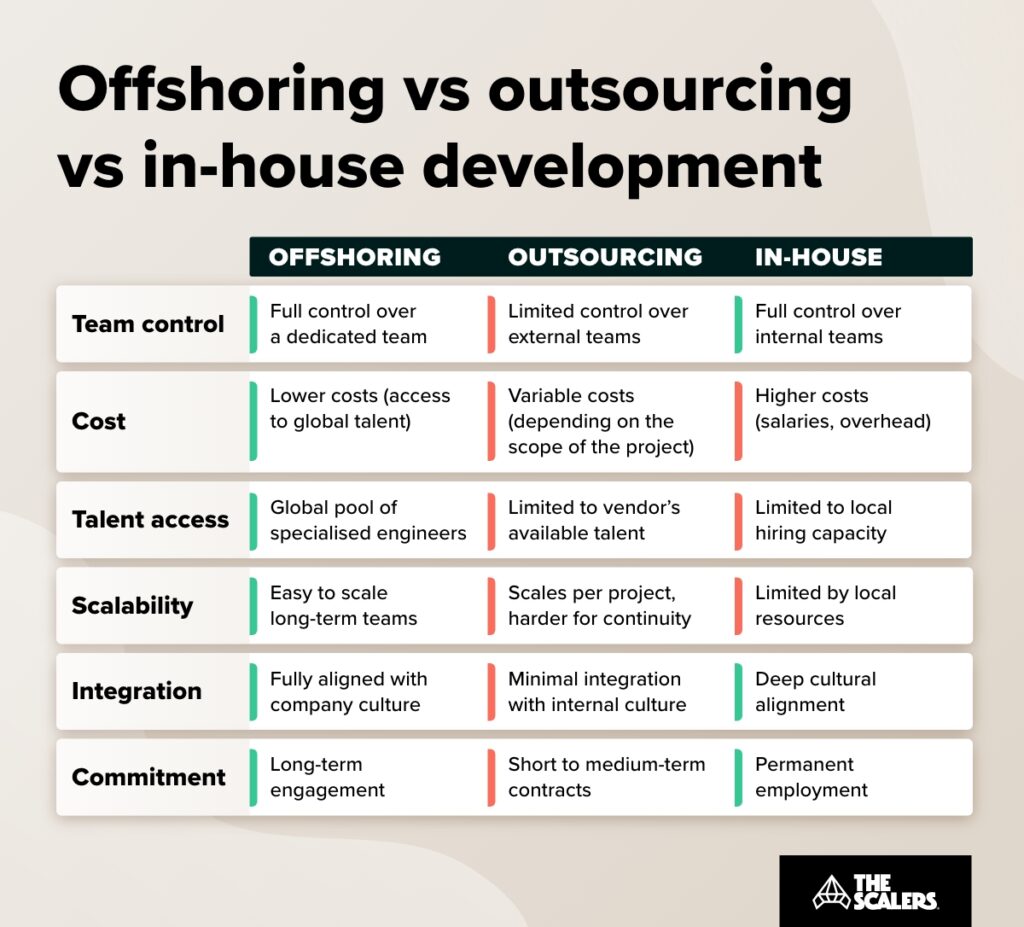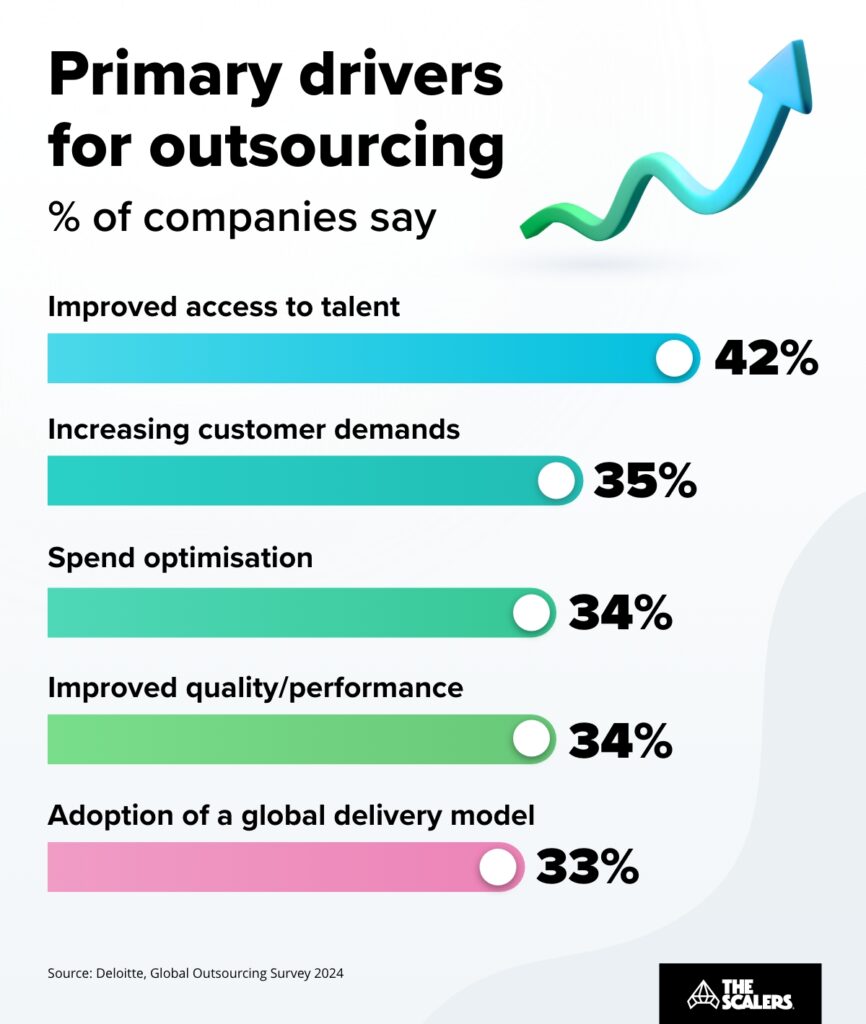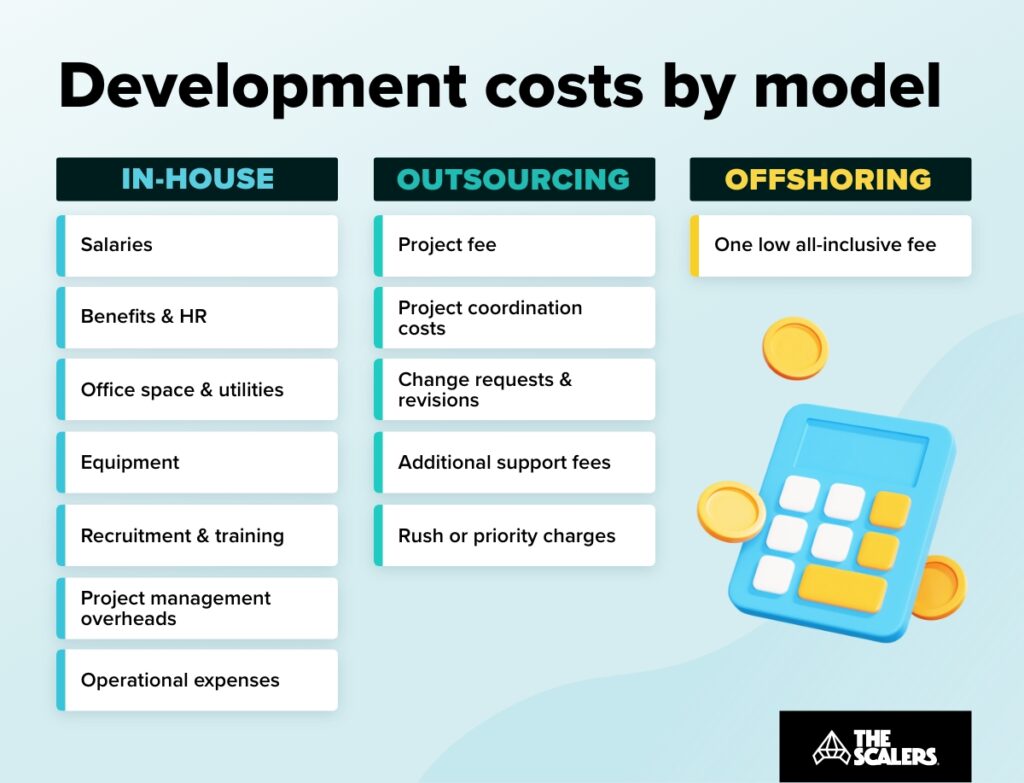Before considering building or extending your tech team, you may wonder what the advantages of choosing one business and hiring model over another are. After all, you want to ensure you’re choosing the right approach to get the talent you’re looking for.
In this article, we analyse the benefits of offshoring, outsourcing, and in-house development, and we compare the three. After reading it, you’ll understand the pros of each model and be able to make an informed decision for your organisation.
We hope you find it helpful!
What are offshoring, outsourcing, and in-house development?
Before comparing these models and their benefits, let’s start by defining each one:
- Offshoring involves hiring dedicated developers in a talent-rich country, typically where costs of living are lower. These professionals work exclusively for your company, following your processes and aligning with your culture.
- Outsourcing refers to hiring an external vendor to handle specific projects or temporary tasks. These teams are not part of your organisation and deliver results based on a predefined scope.
- In-house development involves hiring full-time employees who work directly within your company, usually in your headquarters or local office.
What are the differences between offshoring, outsourcing and in-house development?
Offshoring, outsourcing, and in-house development are among the most popular models to build tech teams. These are the main differences between them across key parameters:
Team control
With offshoring, organisations maintain full control over a dedicated team that works just for them. Contrary to outsourcing, where external teams perform tasks with limited oversight, offshore software development gives businesses direct control over workflows and alignment with their strategic goals.
In-house development also offers full team control, with the difference that the team is physically present and integrated within the company’s internal structure.
Cost
Offshoring is a cost-effective model that sources specialised engineers in countries with a lower level of life than in the US or Europe. While outsourcing is also considered to be an affordable approach, it comes with variable costs that fluctuate depending on project size, duration, and the vendor’s pricing model.
In-house development is the most costly option due to the high salaries, benefits, and operational overhead required to maintain a local team, especially in Western countries.
Talent access
One of the main advantages of offshoring is the ability to tap into a global pool of elite engineers, making it easier to find niche expertise. Outsourcing, however, is limited to the vendor’s available talent, which may not always align with specific technical needs.
In-house development restricts hiring to local talent, which can make it challenging to scale if the required skills are not available in the region.
Scalability
Offshoring offers easy scalability, allowing companies to expand or adjust their team size over time as they grow their product offering. In contrast, outsourcing is typically focused on short-term projects and can be harder to sustain for long-term growth.
In-house development is the least flexible option, as scaling depends on local hiring capacity and can take months to complete.
Integration
When working with a reliable offshore development partner, organisations can hire offshore engineers who are fully aligned with their culture and processes. On the contrary, outsourcing involves minimal integration, as external teams focus just on completing tasks.
In-house development ensures a deep cultural alignment since engineers are full-time employees working in the company’s headquarters.
Commitment
Offshoring guarantees long-term engagement with dedicated engineers who become an integral part of organisations. Outsourcing, on the other hand, usually involves short to medium-term contracts, meaning there is less long-term stability.
In-house development, like offshoring, means a high level of commitment, as engineers are permanent employees.

The key benefits of offshoring
Now that you know the differences between models, let’s analyse the benefits (and drawbacks) of each, starting with offshoring. These are the advantages that set offshoring apart from other approaches:
- Hire expert talent. Through offshoring, you can build a team of engineers who possess valuable programming skills and some of the soft skills tech leaders value the most, like creative thinking. This is especially true for legacy languages and frameworks or the latest tech which isn’t widely known.
- Enjoy great value for money. As discussed earlier, offshoring is a cost-effective model, meaning that you can set up a team with top talent for a fraction of the cost you’d pay at home.
- Get an ‘in-house feeling.’ When done right, offshoring allows you to hire professionals who act as your in-house employees, even though they are thousands of miles away from your headquarters. They are culturally aligned with your organisation and are committed to your success.
- Expand your team on demand. If you build a team via offshoring, you can start with as little as five engineers and scale up to over a hundred as your business grows.
- Benefit from hands-off operations. The right offshore partner can do all the heavy lifting for you, including HR, legal, and other administrative tasks, while you focus on your product.
What are the cons of offshoring?
The major drawback of offshoring is geographical distance. If you decide to go offshore, you must know that your team will be located in a faraway country, so it won’t be possible to regularly visit your engineers. While real-time collaboration may be limited, most offshore setups ensure overlapping work hours with tech teams.
However, some of the best offshore development companies offer unique benefits like organising periodic workations for companies to meet with their offshore teams to strengthen bonds and collaborate face-to-face.
Plus, different time zones can actually work in your favour, as your offshore team keeps things moving while you’re offline, testing overnight and handing off work to speed up delivery.
The key benefits of outsourcing
- Hire top engineers for short-term projects. With outsourcing, you can easily hire professionals with the skill set you need to complete your short-term projects or temporary tasks.
- Save money. Outsourcing is affordable for companies of all sizes, as vendors offer customised services adapted to any budget and project size. Plus, you pay just for what you need, not for overhead costs.
- Optimise resources. Outsourcing lets external vendors handle non-critical tasks, allowing your in-house senior engineers to focus on more important projects.

What are the cons of outsourcing?
Despite affordability being one of outsourcing’s advantages, hidden costs can arise for tasks outside the project scope, so you should be vigilant about that.
Another major con of outsourcing is that engineers lack customer focus as they tend to juggle multiple clients. They are not invested in your goals, mission, and vision. Communication can also be a challenge since you often have to go through a manager instead of speaking directly with engineers.
On top of that, many outsourcing firms struggle to attract top talent, so you might end up with less skilled developers.
The key benefits of in-house development
- Get real-time oversight over development. If you build an in-house team, you can manage engineers at all times and maintain 100% control over the software development process.
- Avoid cultural barriers and communication challenges. With in-house development, you won’t face issues related to cultural nuances or language barriers. Since your team is based in your country or headquarters, you’ll share the same working culture and communication style.
- Maintain stronger security and intellectual property protection. Complete control over your infrastructure ensures better data security and safeguards your intellectual property from external risks.
What are the cons of in-house development?
The two main drawbacks of in-house development are high costs and limited talent pools. Overheads like office space, equipment, and employee benefits add to the expense, while hiring is restricted to your regional availability, limiting access to specialist and niche skills.
Offshoring vs outsourcing vs in-house development: Comparing developer rates
As you may have already noticed, cost is a defining factor for business and tech leaders when deciding which model to use to build tech teams. The cost difference from one approach to another can be quite significant.
Just have a look at the following developer rates taken from the specialised portal Levels.fyi:
- A software engineer in the US earns an average median monthly salary of $15,174.
- A software engineer in a popular outsourcing location like Poland earns a median monthly salary of $5,329.
- A software engineer in a top offshoring location like India earns a median salary of $2,543.
The cost difference between hiring an in-house software engineer in the US and an equivalent offshore specialist in India can be up to 6 times higher!
The below infographic shows how development costs stack up across different models. While in-house and outsourced development come with multiple expenses and hidden fees, offshoring offers a simple, all-inclusive cost.

What’s the best model for building and scaling your tech team?
The best model for setting up and extending your development team depends on your unique needs and requirements:
- If you want full control and face-to-face, real-time collaboration, in-house development is the right solution for your organisation.
- If you want to hire engineers for short-term projects, outsourcing is the way to go.
- If you’re looking for highly specialised talent that contributes to your long-term success, offshoring is the smartest choice.
Overall, offshoring is the most reliable approach, as it provides the best balance of control, quality, and scalability compared to in-house development and outsourcing.
At The Scalers, we’ve crafted a model that allows our partners to hire world-class talent culturally aligned with their values, gives them control over operations, and adapts to their needs.
The best offshore model to build tech teams in Bangalore, India, has helped industry leaders like Nextpoint launch groundbreaking products.
There’s nothing quite like The Scalers where our employees are literally our employees, not coming through any third party company. They know our culture, and our clients so they can execute meaningful code and deliver meaningful features.
Do you want to know more about how we source the top 1% of Indian engineering talent and how we can help you build an elite tech team? Drop us a message by filling out this form, and one of our senior executives will get back to you promptly.
In summary
Despite sharing some similarities, offshoring, outsourcing, and in-house development are different approaches to building tech teams. They serve distinct purposes, but offshoring stands out because of its ability to provide cost-effective access to elite global talent while maintaining full control over your team.
Key takeaways:
-
1
The key benefits of offshoring are access to specialised talent, cost efficiency, on-demand scalability, hands-off operations, and getting an ‘in-house feeling.’
-
2
The key benefits of outsourcing are access to top engineers for short-term projects, affordability, and resource optimisation.
-
3
The key benefits of in-house development are real-time collaboration and direct oversight, the absence of communication barriers, and stronger security and protection of intellectual property.
-
4
The Scalers’ offshore model offers fully managed operations with dedicated engineers aligned to partners’ missions and values.
Thank you for reading this far, and see you in the next one!
Build Your Team,
Not Just a Contract
With The Scalers’ offshore dedicated development team, you get engineers who join your workflow for the long run. Grow steadily, stay flexible, and work with people who care about the product as much as you do.








